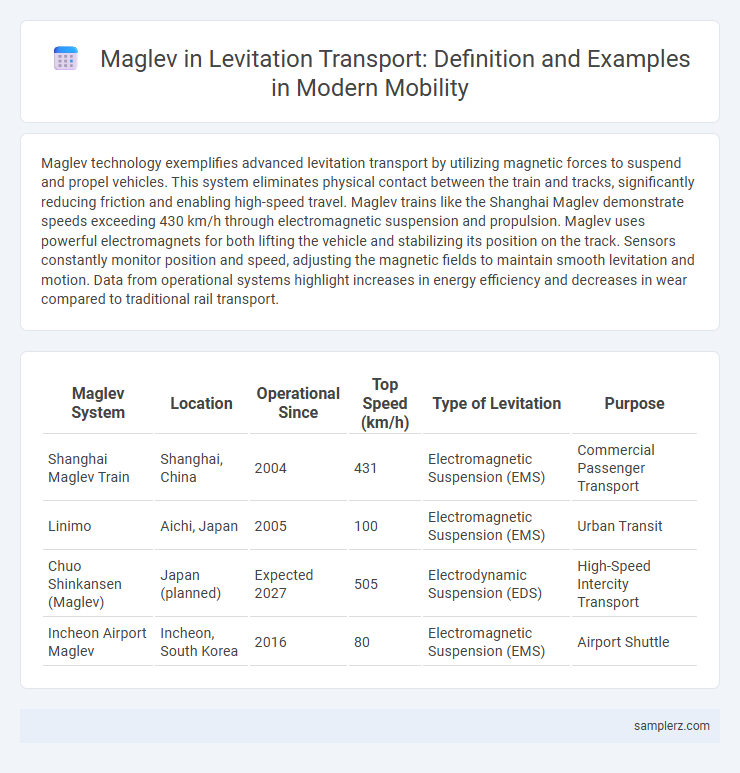Maglev technology exemplifies advanced levitation transport by utilizing magnetic forces to suspend and propel vehicles. This system eliminates physical contact between the train and tracks, significantly reducing friction and enabling high-speed travel. Maglev trains like the Shanghai Maglev demonstrate speeds exceeding 430 km/h through electromagnetic suspension and propulsion. Maglev uses powerful electromagnets for both lifting the vehicle and stabilizing its position on the track. Sensors constantly monitor position and speed, adjusting the magnetic fields to maintain smooth levitation and motion. Data from operational systems highlight increases in energy efficiency and decreases in wear compared to traditional rail transport.
Table of Comparison
| Maglev System | Location | Operational Since | Top Speed (km/h) | Type of Levitation | Purpose |
|---|---|---|---|---|---|
| Shanghai Maglev Train | Shanghai, China | 2004 | 431 | Electromagnetic Suspension (EMS) | Commercial Passenger Transport |
| Linimo | Aichi, Japan | 2005 | 100 | Electromagnetic Suspension (EMS) | Urban Transit |
| Chuo Shinkansen (Maglev) | Japan (planned) | Expected 2027 | 505 | Electrodynamic Suspension (EDS) | High-Speed Intercity Transport |
| Incheon Airport Maglev | Incheon, South Korea | 2016 | 80 | Electromagnetic Suspension (EMS) | Airport Shuttle |
Introduction to Maglev Technology in Mobility
Maglev technology utilizes powerful electromagnetic forces to achieve frictionless levitation and propulsion, enabling trains to reach speeds exceeding 600 km/h with exceptional stability and efficiency. This technology reduces mechanical wear and energy consumption by eliminating physical contact between the train and track, significantly enhancing travel time and passenger comfort. Maglev systems, such as Japan's SCMaglev and China's Shanghai Maglev, demonstrate advanced applications in urban and intercity transportation infrastructure, setting new standards for high-speed rail mobility worldwide.
How Maglev Levitation Transforms Transport
Maglev levitation uses powerful electromagnets to lift trains above the tracks, eliminating friction and enabling speeds over 300 mph. This technology enhances energy efficiency, reduces maintenance costs, and provides ultra-smooth rides with minimal noise pollution. Cities adopting maglev systems experience faster, more reliable transit options that revolutionize sustainable urban mobility.
Notable Maglev Train Systems Worldwide
Notable maglev train systems worldwide include the Shanghai Maglev in China, the fastest commercial maglev reaching speeds of 430 km/h, and the Linimo in Japan, which integrates urban transit with magnetic levitation technology. Germany's Transrapid project demonstrated high-speed capabilities and precision control but was limited to test tracks and proposals. These systems showcase the potential of maglev technology to revolutionize urban and intercity mobility by eliminating friction and enabling ultra-fast, efficient transport.
Case Study: Shanghai Maglev, China
The Shanghai Maglev Train exemplifies high-speed levitation transport, reaching speeds of up to 431 km/h using electromagnetic suspension technology. This 30-kilometer line connects Pudong International Airport with the outskirts of central Shanghai, significantly reducing travel time to just 7 minutes. Its operational efficiency and reduced friction highlight the advantages of maglev systems in urban mobility and sustainable transportation infrastructure.
SCMaglev: Japan’s High-Speed Levitation Innovation
SCMaglev, developed by Japan Railway Company (JR Central), exemplifies cutting-edge magnetic levitation technology, achieving speeds up to 603 km/h by utilizing superconducting magnets and electromagnetic suspension systems. This high-speed levitation train minimizes friction and air resistance, enabling rapid acceleration and energy efficiency on dedicated maglev tracks. SCMaglev represents a significant advancement in sustainable urban and intercity mobility, reducing travel times while promoting eco-friendly transportation solutions.
Maglev Applications in Urban Transit
Maglev technology revolutionizes urban transit by enabling high-speed, frictionless travel through electromagnetic levitation, significantly reducing travel time and maintenance costs. Cities like Shanghai and Tokyo utilize maglev trains to enhance commuter efficiency and reduce urban congestion. Integration of maglev systems in metropolitan areas offers sustainable, energy-efficient alternatives to traditional rail networks.
Comparison: Maglev vs Conventional Rail Transport
Maglev trains utilize electromagnetic levitation to eliminate track friction, enabling speeds exceeding 300 mph, whereas conventional rail relies on steel wheels on tracks, limiting speeds due to friction and mechanical wear. Energy efficiency in maglev systems is higher because reduced friction decreases power consumption, contrasting with conventional rail that faces energy losses from rolling resistance and track maintenance. Maintenance costs for maglev are lower over time as there is minimal contact-based wear, while conventional rail demands frequent repairs and track replacements to ensure safety and performance.
Future-Proof Mobility: Emerging Maglev Projects
Emerging maglev projects, such as Japan's SCMaglev and China's Shanghai Maglev Expansion, demonstrate significant advancements in levitation transport with speeds exceeding 600 km/h and enhanced energy efficiency. These future-proof mobility solutions integrate superconducting magnets and advanced control systems to reduce friction and maintenance costs while increasing passenger capacity. Maglev technology promises to revolutionize urban and intercity travel by offering sustainable, rapid transit options with minimal environmental impact.
Sustainability Benefits of Maglev Levitation Transport
Maglev levitation transport significantly reduces friction by suspending trains above the tracks using magnetic forces, resulting in lower energy consumption compared to conventional rail systems. This technology produces zero direct emissions as it relies primarily on electricity, which can be sourced from renewable energy, enhancing its environmental sustainability. The quiet operation and minimal wear and tear on infrastructure contribute to reduced noise pollution and lower maintenance costs, supporting long-term sustainable urban mobility.
Challenges and Opportunities for Maglev Mobility
Maglev technology faces significant challenges including high infrastructure costs, complex maintenance requirements, and the need for extensive urban planning to integrate tracks seamlessly with existing transportation networks. Opportunities for maglev mobility include ultra-high-speed travel capabilities, reduced environmental impact due to low friction and emissions, and enhanced safety from fewer moving parts and advanced control systems. Advancements in superconducting materials and cost-effective construction methods could accelerate the widespread adoption of maglev trains in metropolitan and intercity transport.

example of maglev in levitation transport Infographic
 samplerz.com
samplerz.com